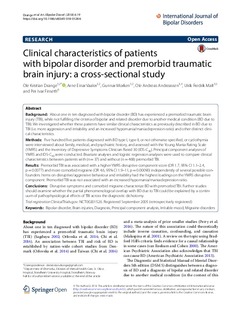| dc.contributor.author | Drange, Ole Kristian | |
| dc.contributor.author | Vaaler, Arne | |
| dc.contributor.author | Morken, Gunnar | |
| dc.contributor.author | Andreassen, Ole Andreas | |
| dc.contributor.author | Malt, Ulrik Fredrik | |
| dc.contributor.author | Finseth, Per Ivar | |
| dc.date.accessioned | 2018-09-18T11:04:50Z | |
| dc.date.available | 2018-09-18T11:04:50Z | |
| dc.date.created | 2018-09-10T22:38:44Z | |
| dc.date.issued | 2018 | |
| dc.identifier.citation | International journal of bipolar disorders. 2018, . | nb_NO |
| dc.identifier.issn | 2194-7511 | |
| dc.identifier.uri | http://hdl.handle.net/11250/2563176 | |
| dc.description.abstract | Background
About one in ten diagnosed with bipolar disorder (BD) has experienced a premorbid traumatic brain injury (TBI), while not fulfilling the criteria of bipolar and related disorder due to another medical condition (BD due to TBI). We investigated whether these patients have similar clinical characteristics as previously described in BD due to TBI (i.e. more aggression and irritability and an increased hypomania/mania:depression ratio) and other distinct clinical characteristics.
Methods
Five hundred five patients diagnosed with BD type I, type II, or not otherwise specified, or cyclothymia were interviewed about family, medical, and psychiatric history, and assessed with the Young Mania Rating Scale (YMRS) and the Inventory of Depressive Symptoms Clinician Rated 30 (IDS-C30). Principal component analyses of YMRS and IDS-C30 were conducted. Bivariate analyses and logistic regression analyses were used to compare clinical characteristics between patients with (n = 37) and without (n = 468) premorbid TBI.
Results
Premorbid TBI was associated with a higher YMRS disruptive component score (OR 1.7, 95% CI 1.1–2.4, p = 0.0077) and more comorbid migraine (OR 4.6, 95% CI 1.9–11, p = 0.00090) independently of several possible confounders. Items on disruptive/aggressive behaviour and irritability had the highest loadings on the YMRS disruptive component. Premorbid TBI was not associated with an increased hypomania/mania:depression ratio.
Conclusions
Disruptive symptoms and comorbid migraine characterize BD with premorbid TBI. Further studies should examine whether the partial phenomenological overlap with BD due to TBI could be explained by a continuum of pathophysiological effects of TBI across the diagnostic dichotomy. | nb_NO |
| dc.language.iso | eng | nb_NO |
| dc.publisher | SpringerOpen | nb_NO |
| dc.rights | Navngivelse 4.0 Internasjonal | * |
| dc.rights.uri | http://creativecommons.org/licenses/by/4.0/deed.no | * |
| dc.title | Clinical characteristics of patients with bipolar disorder and premorbid traumatic brain injury: a cross-sectional study | nb_NO |
| dc.type | Journal article | nb_NO |
| dc.type | Peer reviewed | nb_NO |
| dc.description.version | publishedVersion | nb_NO |
| dc.source.pagenumber | 10 | nb_NO |
| dc.source.journal | International journal of bipolar disorders | nb_NO |
| dc.identifier.doi | https://doi.org/10.1186/s40345-018-0128-6 | |
| dc.identifier.cristin | 1608255 | |
| dc.description.localcode | © The Author(s) 2018. This article is distributed under the terms of the Creative Commons Attribution 4.0 International License (http://creativecommons.org/licenses/by/4.0/) | nb_NO |
| cristin.unitcode | 194,65,35,0 | |
| cristin.unitcode | 194,65,1,0 | |
| cristin.unitname | Institutt for psykisk helse | |
| cristin.unitname | MH fakultetsadministrasjon | |
| cristin.ispublished | true | |
| cristin.fulltext | original | |
| cristin.qualitycode | 1 | |

